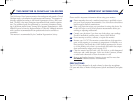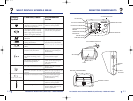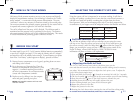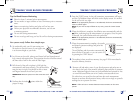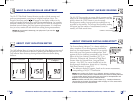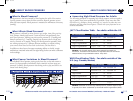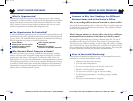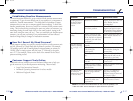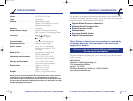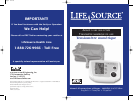
LifeSource Health Line (Toll-Free): 1-888-726-9966
E-14
What Is Hypertension?
Hypertension (high blood pressure) is the diagnosis given when readings
consistently rise above normal. It is well known that hypertension can lead to
stroke, heart attack or other illness if left untreated. Referred to as a “silent
killer” because it does not always produce symptoms that alert you to the
problem, hypertension is treatable when diagnosed early.
Can Hypertension Be Controlled?
In many individuals, hypertension can be controlled by altering lifestyle and-
minimizing stress, and by appropriate medication prescribed and monitored
by your doctor. The American Heart Association recommends the following
lifestyle suggestions to prevent or control hypertension:
lacisyhp raluger evaH.ekoms t’noD
Reduce salt and fat intake. checkups.
Maintain proper weight. Monitor your blood
Exercise routinely. pressure at periodic intervals.
Why Measure Blood Pressure at Home?
It is now well known that, for many individuals, blood pressure readings
taken in a doctor’s office or hospital setting might be elevated as a result of
apprehension and anxiety. This response is commonly called “white coat
hypertension.” In any case, self-measurement at home supplements your doc-
tor’s readings and provides a more accurate, complete blood pressure history.
In addition, clinical studies have shown that the detection and treatment of
hypertension is improved when patients both consult their physicians and
monitor their own blood pressure at home.
E-15
ABOUT BLOOD PRESSURE
ABOUT BLOOD PRESSURE
Answers to Why Your Readings Are Different
Between Home and at the Doctor’s Office
Why are my readings different between home and at a doctor’s office?
Your blood pressure readings taken in a doctor’s office or hospital setting may
be elevated as a result of apprehension and anxiety. This response is known
as white coat hypertension.
When I bring my monitor to a doctor’s office, why do I get a different
measurement from my monitor to that taken by a doctor or nurse?
The healthcare professional may be using a different sized cuff. The size of
the bladder inside the cuff is critical for the accuracy of the measurement.
This may give you a different reading. A cuff too large will produce a reading
that is lower than the correct blood pressure; a cuff that is too small will pro-
duce a reading that is higher than the correct blood pressure. There may also
be other factors that can cause the difference
in measurements.
Keys to Successful Monitoring:
Blood pressure fluctuates throughout the day. We recommend that you are
consistent in your daily measurement routine:
• Measure at the same time every day.
• Sit in the same chair/position.
• Do not cross legs and keep your feet flat on the floor.
• Relax for 5 minutes before measurement.
• Use the correct cuff size to get an accurate reading.
• Sit still during measurement – no talking, eating or sudden
movements.
• Record your measurement in a logbook.
Page 18-19
In Canada–Auto Control Medical (Toll-Free): 1-800-461-0991




